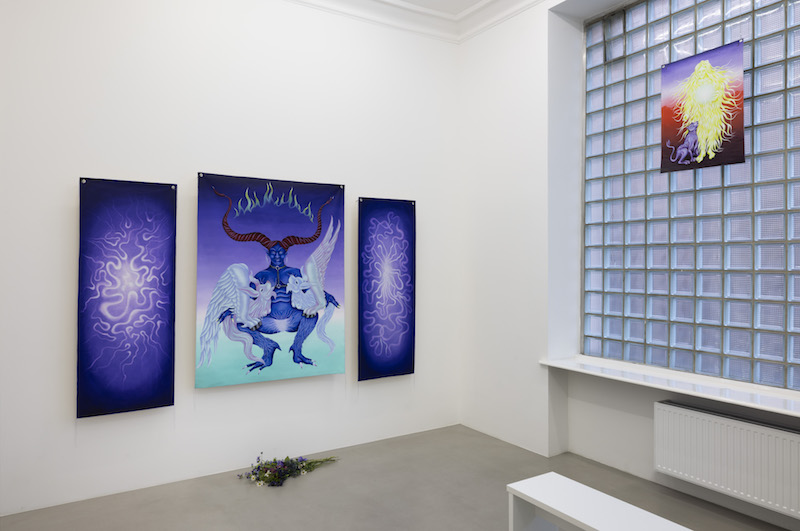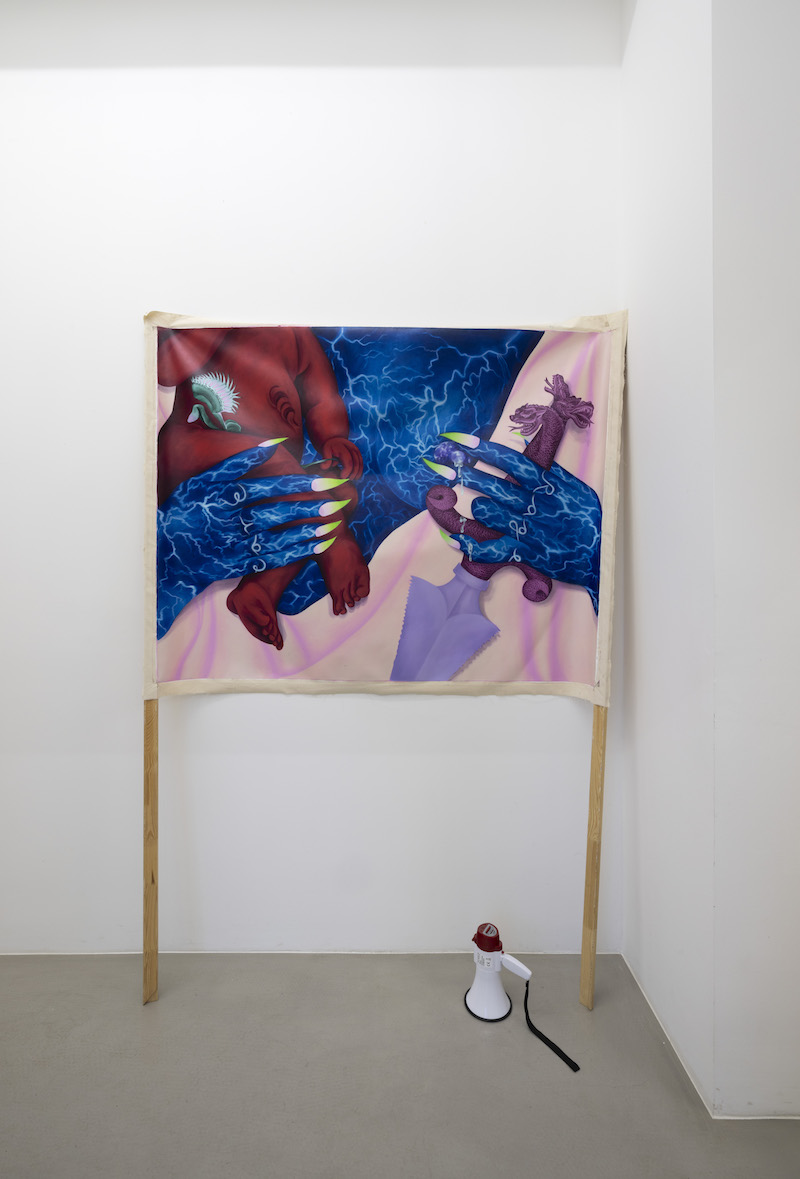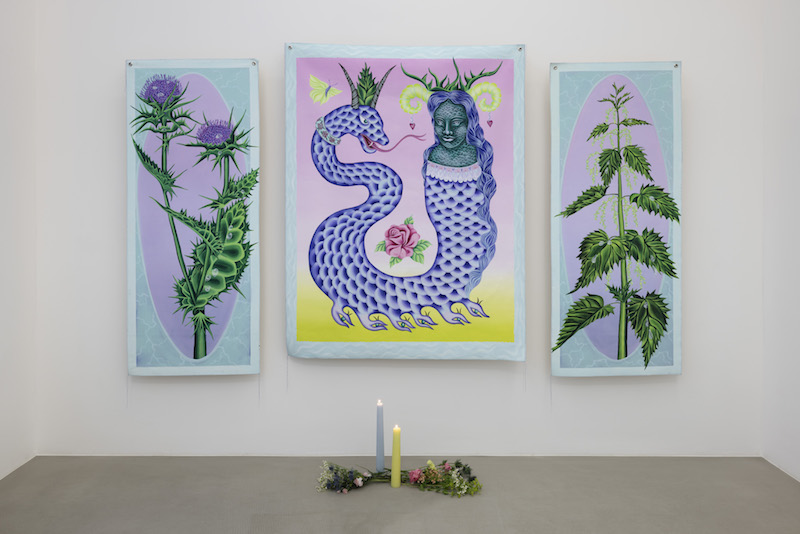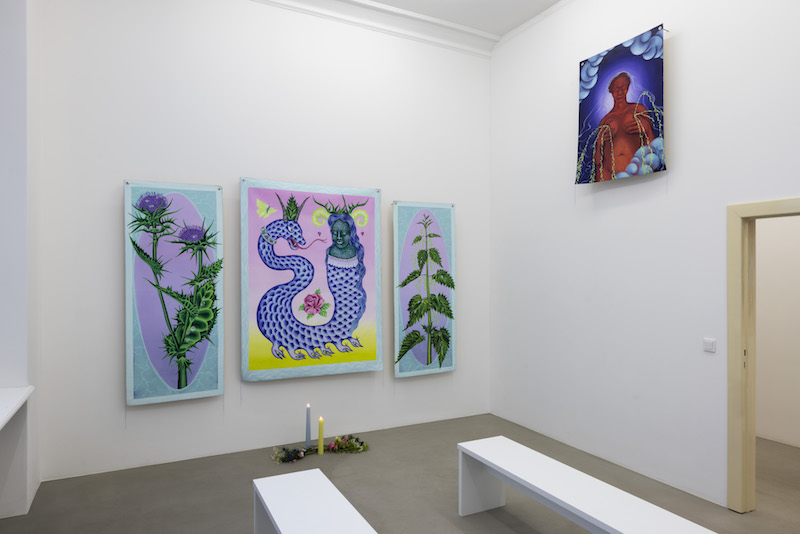by Gillian N. Osborne // Mar. 3, 2023
Marleen Rothaus has exploited the nave-like architecture of ChertLüdde’s Bungalow, hanging a series of new paintings to mimic a sanctuary of rest. In ‘Chapel of Care and Rage,’ we are invited to imbibe rich visual imagery of mythical goddesses, animal figures and medicinal plants as they peer down on us from on high. But while the paintings have a colourful simplicity, the theory and practice behind them is more complex. To viewers unfamiliar with Jineolojî – whose principles Rothaus followed in producing these works – or the history of the figures depicted, the paintings might remain on the level of aesthetic symbolism. Yet those familiar with Christian spaces will immediately sense the challenge these strong, threatening maternal figures pose to a Western concept of motherhood as exemplified by the Virgin Mary.

Marleen Rothaus: ‘Chapel of Care and Rage,’ installation view, BUNGALOW/ChertLüdde, Berlin, 2023 // Photo by Andrea Rossetti, courtesy of ChertLüdde, Berlin and Marleen Rothaus, Köln
Jineolojî is a movement for gender-equality that originates in Rojava, an autonomous region in northern Syria, and is a key component of governance in the region. Jineolojî presents a more holistic and inclusive alternative to Western feminism in rejecting all forms of hegemony, patriarchy included. One key aim is to recover and study knowledge about women, and to place more value on aspects of human existence seen as “feminine.” In line with these aims, Rothaus presents us with various maternal tropes that have persisted throughout history.
The largest and most ambiguous painting of the show stands like a banner outside the chapel. Two blue, marbled hands fill the canvas, their knuckles tattooed with the words “care” and “rage.” One forearm balances a menacing red baby, while the right hand squeezes a viscous, milk-like substance from a blue nipple while clutching a bright purple dagger. Lactating breasts are a recurring theme in the show, presumably as a direct symbol for maternal care. Blocks of bright colour lend the works a sense of caricature, juxtaposed by the references to Christian religious imagery, with the deep red baby perched weightlessly like a sacred child borne by God.

Marleen Rothaus: ‘Care, Rage,’ 2022, installation view ‘Chapel of Care and Rage,’ BUNGALOW/ChertLüdde, Berlin, 2023 // Photo by Andrea Rossetti, courtesy of ChertLüdde, Berlin and Marleen Rothaus, Köln
Inside the “chapel” itself, two triptychs hang on opposite walls, watched over by a pair of single works hung higher in the space. The triptychs, evoking classic Christian altarpieces, feature threatening half-animal figures: ‘Mother of Change,’ Rothaus’ rendition of the ‘Burney Relief’ (1800 BCE), depicts a female satyr – a being thought to be obsessed with pleasure. White hot veins burst out from the satyr’s open crotch, while fire burns between her colossal horns and two dragonesque creatures drink from her breasts. She dares us to attempt her subordination, to conflate the idea of caregiving with weakness or passivity. The canvasses on either side hold fields of energy emerging out of a purple blackness. Perhaps symbolising the life-giving force of the lactating breast, with its swollen, veiny texture, the pieces lend a sense of further power to the central image, as if force-fields of the satyr’s influence.

Marleen Rothaus: ‘Thorny Secret, The Secrets Keeper, Burning Secret,’ 2023, installation view BUNGALOW/ChertLüdde, Berlin, 2023 // Photo by Andrea Rossetti, courtesy of ChertLüdde, Berlin and Marleen Rothaus, Köln
In ‘The Secrets Keeper,’ Shahmaran—a mythological creature that is half-woman, half-snake—is flanked by the enlarged stems of a milk thistle and a nettle. Shahmaran’s stare challenges us to approach her, while the snake threatens to protect her at all cost. A rose hangs between them, and heart-shaped earrings dangle from Shahmaran’s horns. There’s a sense here in which decorative, so-called “feminine” imagery is reinstated at the seat of power and self-determination, a sense reinforced by the bright colours of the painting. The plant stems either side are portrayed in a cartoonish realism, while droplets of water roll off their leaves, evoking the milk dripping from nipples in the other pieces of the exhibition. Two figures suggestive of the Virgin Mary watch over the scene: one emits a holy light from her body, while the other’s breasts form fountains of milk that gush down on the watchers below.
Several footnotes in the exhibition text help to clarify Rothaus’ working methods and the origins of the figures she depicts. Yet the information provided functions as an invitation to further investigation, rather than an explanation of the work’s relevance. The extent to which a viewer will appreciate the real history and persistence of these myths and archetypes through the work itself is unclear. This is exacerbated by Rothaus’ two-dimensional, cartoonish style and her use of colour. There is a strong sense that these illustrative, static figures are symbols, but what exactly they represent is not altogether clear. Some figures come dangerously close to resembling printed yoga merchandise. In other works, the thematic colours are so suspiciously on-trend that they could be branding for a hip fashion label.

Marleen Rothaus: ‘Chapel of Care and Rage,’ installation view, BUNGALOW/ChertLüdde, Berlin, 2023 // Photo by Andrea Rossetti, courtesy of ChertLüdde, Berlin and Marleen Rothaus, Köln
Nevertheless, simply by subverting the traditional image of a caring, meek, self-sacrificing mother, Rothaus forces us to see the ubiquity of that image and to question its legitimacy and hegemony. She offers an alternative image of motherhood that is caring but strong, giving but enraged, loving but defiant.
To some extent, Rothaus’ use of the principles of Jineolojî have functioned as intended. Even if some references in the show are less obvious, she nevertheless questions hegemonic ideals that work to oppress women. In recognising the maternal models that uphold at least some of our current power-relations, we take a further step towards gender equality. More importantly, in bringing this ground-breaking feminist movement to our attention, Rothaus presents us not only with an opportunity to develop a more intersectional feminism, but also with the possibility of supporting activists who are making gender equality a reality.
Exhibition Info
ChertLüdde
Marleen Rothaus: ‘Chapel of Care and Rage’
Exhibition: Feb. 4 – Apr. 6, 2023
chertluedde.com
Hauptstraße 18, 10827 Berlin, click here for map





















